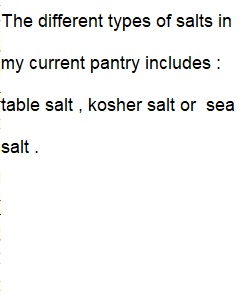


Q Lab 4 Primary Taste Review and Application Experimental Design: You will be completing the following activities using everyday perishable or non-perishable product items that can elicit individual taste senses. Sucrose (Table Sugar = Sweet). In Chapter 17, there are several alternate sweeteners listed and readily used in many food products today. Take a look at your non-perishable food products that contain sugar or alternative sweeteners and think of products to determine if temperatures affect the levels of sweetness in foods. Complete the questions below with short answer responses. 1. What are the pros and cons of using table sugar versus alternative sweeteners? 2. Are foods sweeter at cooler temperatures or hot temperatures? Sodium Chloride (NaCl or salt = salty). There are so many options now at the store that it can be difficult for consumers to differentiate what each one means. Complete the following activity, address the following two questions and submit in an APA format, 12 font Arial, double spaced with cover page, main body and references. Paper should be approximately 1-2 pages (not including the cover page and references) and submitted in Microsoft Word, Google Docs or Adobe PDF. 1. What types of salt products do you have in your current pantry? 2. Compare and contrast the following types of salt products available for consumers to purchase. a. Himalayan Salt b. Sea Salt c. Table Salt d. Kosher Salt e. Curing Salts f. Hawaiian Black Salt Tartaric Acid (Cream of tartar – sour). Sour flavoring is common in many foods, such as Asian cuisines, coupled with sweetness or hard candies. We also use products such as lemon or lime, which to some, elicit a sour flavoring. Sour can even recognize spoiled foods and an alarm for us to avoid consuming the product itself. Complete the following activity, address the following two questions and submit in an APA format, 12 font Arial, double spaced with cover page, main body and references. Paper should be approximately 1-2 pages (not including the cover page and references) and submitted in Microsoft Word, Google Docs or Adobe PDF. 1. Look in your current perishable and non-perishable items and list what would fall under eliciting the sour taste. 2. Of the 5 primary taste sensations (sweet, salty, sour, bitter and umami), research foods which elicit the bitter and umami. Nutrigenomics. In Chapter 3, we discussed how genetics determine if we can recognize certain chemicals. One of these chemicals that can be detected we will be detecting is PTC and sodium benzoate. Individuals who can elicit sodium benzoate tend to find the product salty, bitter or sweet. PTC can vary among ethnic groups and is considered a dominant trait found in . Lab 4 Primary Taste Review and Application Cruciferous vegetables such as cabbage, cauliflower, broccoli, Brussel sprouts, kale cottage, cheddar cheese, coffee, colas, grapefruit, and sauerkraut. Complete the questions below with short answer responses. 1. What is the US national average of the population who can detect PTC and Sodium Benzoate? 2. Within the national average, which ethnicity group can/cannot detect PTC and Sodium Benzoate 3. Scan your current perishable/non-perishable products and determine if you have any products which may contain sodium benzoate or PTC. If so, list the products you found. If you do not have any products containing PTC or sodium benzoate, list 3 products items available for consumers. Sensory Evaluation Application. Today, there are cooking, and baking shows readily available to showcase simple cooking to outdoorsy cooking or competition cooking. Watch an episode on YouTube, Netflix, Food Network of any reality food cooking show (i.e., Chopped, Final Table, Iron Chef, Beat Bobby Flay). Complete the questions below with short answer responses. 1. Who were the judges? 2. What were the judges known for? 3. Who were the contestants? 4. What were the contestant’s backgrounds? 5. What were the ingredients used for the meal being evaluated? 6. Of the five primary tastes, what tastes were presented in the item judged? 7. What were the comments made for each contestant? 8. Who was the winner? 9. Why did they win? 10. If you were a judge on the panel, who would you have recommended, and why? Extra Credit: During this global COVID19-Pandemic, one of the most important precautionary measures for healthcare workers is having appropriate personal protective equipment or PPE. According to CDC guidelines, several masks are recommended for providers who provide aerosol-generating procedures (AGP) or taking care of patients who are confirmed positive with COVID19. These masks are known as N95s, and there are several models and uses specific to the procedure performed. Before an individual uses an N95s, fit testing is conducted to ensure the mask fits the user’s face and assessed at least annually. Several factors, such as facial hair and weight changes, may affect the tight-fitting seal needing the mask to be functional. Two of the testing agents are bitter and sweet solutions. Questions to address: 1. Find two (2) N95s models used within the healthcare industry. What are they specifically used for? 2. What is the alternate option for individuals who fail or cannot fit into an N95 mask/model for direct patient care use according to the CDC guidelines? Complete the following activity, address the following two questions and submit in an APA format, 12 font Arial, double spaced with cover page, main body and references. Paper should Lab 4 Primary Taste Review and Application be approximately 2-3 pages (not including the cover page and references) and submitted in Microsoft Word, Google Docs or Adobe PDF. Readings & Resources: Contemporary Nutrition, 5th Edition: Chapter 17 Contemporary Nutrition, 5th Edition: Chapter 3 Article: Taste Perception Article: Alternative Sweeteners Article: Salt Review Article: Nutrigenomics Article: Umami Review Article: Fit Testing Article: Fit Testing 2 OSHA Guidelines: https://www.osha.gov/personal-protective-equipment CDC Guidelines: https://www.cdc.gov/ OSHA Guidelines: Fit Testing https://www.osha.gov/laws-
View Related Questions